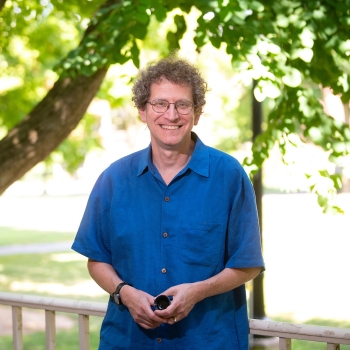When Professor Tom Solomon first learned about the Inside-Out Prison Exchange Program, he didn’t approach it with a plan. He approached it with possibility. It was a conversation with Professor Carolynn Davis, a Bucknell faculty member deeply involved in prison education, that first sparked his interest. She held an information session for faculty, and the idea of teaching inside a prison stood out. The concept felt important, even urgent.
It didn’t take long for that curiosity to deepen. A phone call with Lori Pompa, the program’s founder at Temple University, helped clarify what was at stake. In just thirty minutes, something shifted. Solomon felt inspired and committed. He would become part of this.
Inside-Out courses have historically drawn their strength from the humanities and social sciences, fields rooted in interpretation, ethical inquiry, and dialogue. But Solomon, a scientist, didn’t see that as a limitation. He saw it as an invitation.
He believed science belonged in this space, too. That those on the inside shouldn’t be shut out of discovery, inquiry, or the unfolding questions that shape the world. And so he began building one of the few science-anchored Inside-Out courses in the country, not to replace the existing model, but to expand what it could hold.
Two Circles, One Classroom
Inside-Out courses are not ordinary classrooms. They are bridges, between those who have been incarcerated and those who have not. Between people shaped by very different systems, life experiences, and understandings of freedom.
Before the course even begins, Solomon meets with each group, inside students and outside students, separately. He sets the tone. Expectations are shared. Questions are encouraged. From the start, trust is treated as something that has to be built, not assumed.
Early sessions often include ice-breakers. Conversations that might feel light at first glance, but which gradually help students shed the fear of being misunderstood. As Solomon describes it, even silly topics have power. They open people up. They allow students to feel like people again, not roles they’ve been assigned.
It’s here, in these shared circles of vulnerability and dialogue, that real learning begins.
Lessons You Can’t Plan For

Over the course of the semester, students begin not just to learn, but to witness. Scientific ideas are taught, but they’re not kept at arm’s length. Instead, they are placed into real-life context, explored through lived experience.
In one session, Solomon invited students to discuss the impact of digital technology. Responses were strikingly different. Incarcerated students shared how video conferencing allowed them to see family members who couldn’t visit in person, how even a fleeting digital presence felt like a lifeline. For outside students, the conversation turned toward social media and the anxieties it breeds. For some, technology deepened relationships. For others, it eroded them.
The insight wasn’t abstract. It wasn’t theoretical. It came from sitting in a room with someone whose view of the world had been shaped by entirely different circumstances.
These moments—unscripted, unexpected—are where the course becomes something more than a syllabus.
A Classroom That Doesn’t Exist Anywhere Else
“There’s no other course like this,” Solomon affirms. Not in its design, not in its emotional stakes, and certainly not in the way it draws from the richness of multiple worlds.
The classroom is filled with perspectives that are rarely heard in tandem. Students learn not just about science, but about injustice; about what it means to live inside a system that punishes rather than rehabilitates.
After one course ended, Solomon learned that an incarcerated student, someone who had participated throughout the semester, had been released. He had served 17 years for a crime he didn’t commit. The district attorney’s office had discovered that the main witness in the case had committed perjury.
“Justice isn’t just about who’s charged with a crime or who’s in prison,” Solomon reflects. “It’s also about the inequities people face around us every day. And we’ve seen quite a bit of that.”
Inside-Out doesn’t just expose students to injustice. It forces them to sit with it. To ask what it means to be held accountable in a world where access, fairness, and truth don’t always align. And in stories like these, the classroom’s lessons continue to echo—reminding students that the systems they examine are still shaping lives in real time.
Science, Justice, and the Possibility of Care
At its heart, Solomon’s course “Science, Technology and Society” is a challenge to the idea that science must be impersonal. In this classroom, science is deeply human. It’s about air systems, infrastructure, and technology, but also about ethics, responsibility, and power. It’s about what happens when the questions we ask in textbooks are applied to lives that have been shaped by systemic exclusion.
And in that process, something shifts. Incarcerated students reclaim knowledge as their own. Outside students encounter systems they had previously only read about. Together, they reflect on responsibility, not only in scientific inquiry, but in how we treat each other.
Beyond the Classroom Walls
Solomon sees education not just as a means of knowledge, but as a form of connection. Especially in today’s world—where higher education is often under attack, and misunderstanding is weaponized—he believes learning spaces like Inside-Out matter more than ever.
“Education is key for everything,” he explains. It provides career skills, yes, but more than that, it shapes how we view the world and each other. For many of his inside students, the course represents a first serious exposure to structured academic learning. And for all involved, it’s a rare opportunity to cross the boundaries that so often divide us.
Inside-Out courses can’t fix broken systems. But they can remind us that transformation begins with proximity. That empathy begins with dialogue. That understanding begins not when we speak, but when we listen.
Not as inmates or students. But as people.
And maybe, that’s the most important lesson of all.